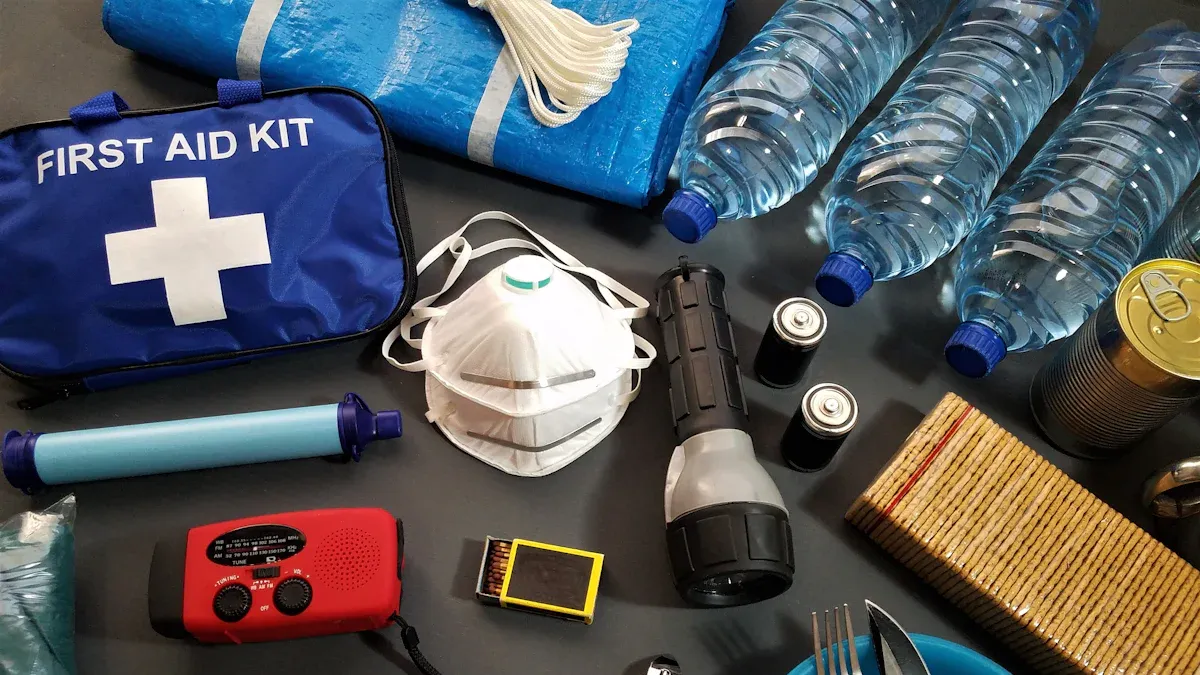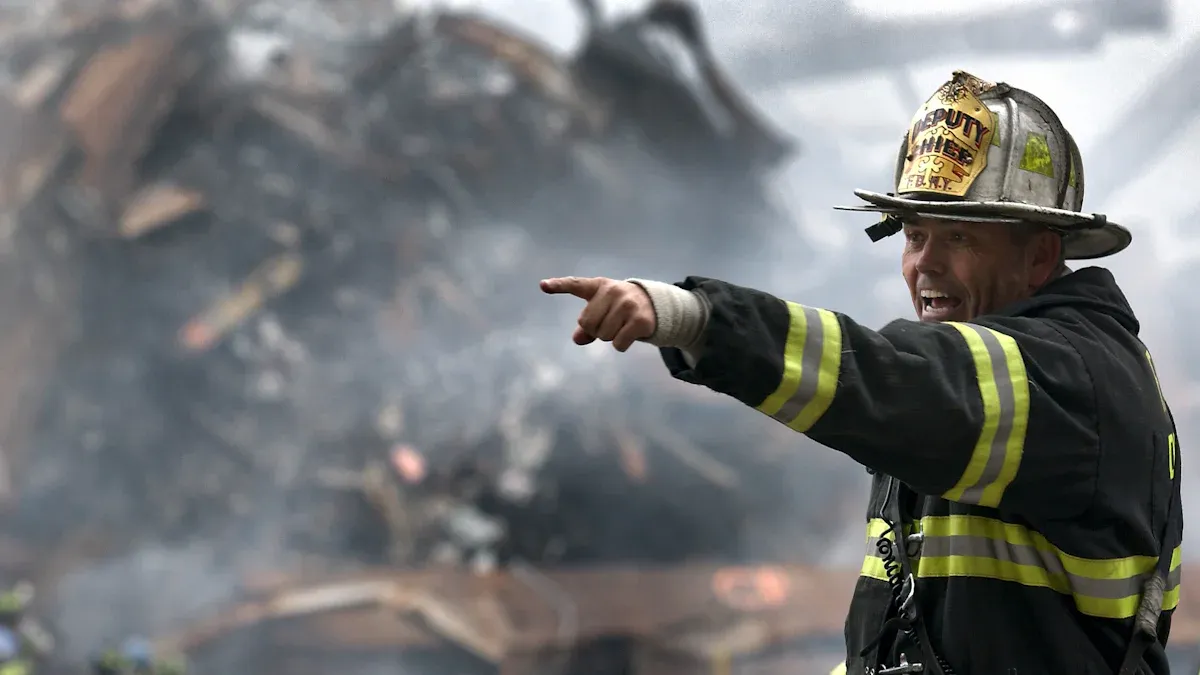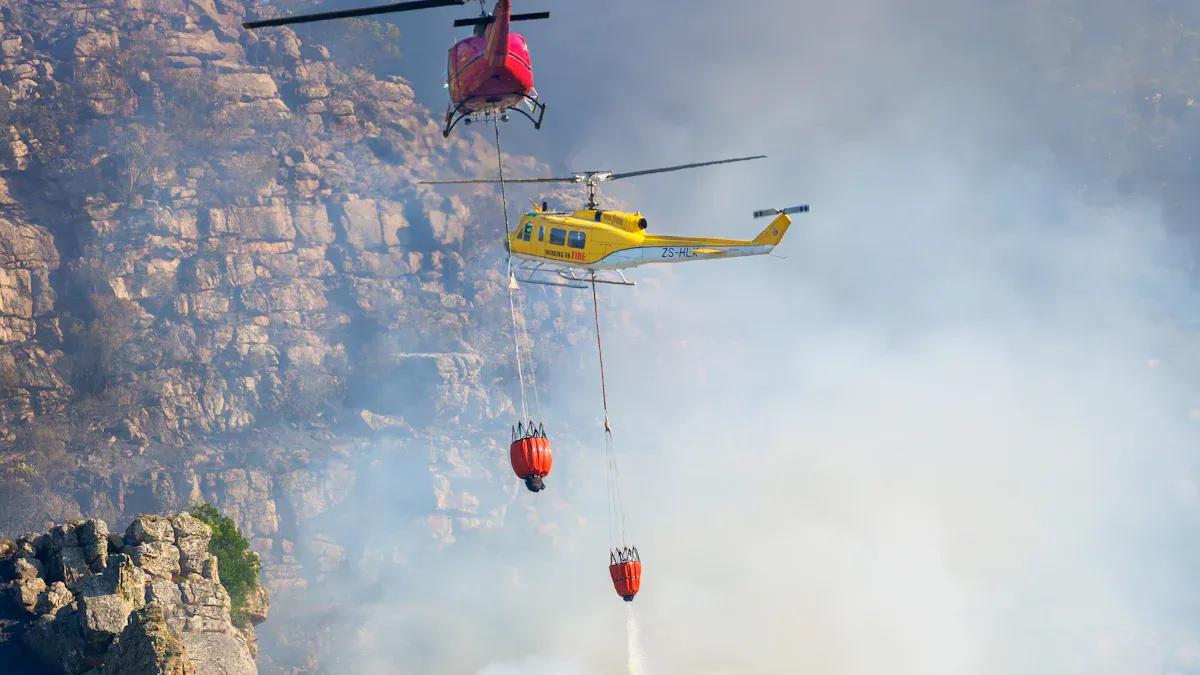
Lighting serves as a cornerstone in disaster relief operations, ensuring visibility and safety in chaotic environments. AAA headlamps, with their compact design and dependable performance, address the critical need for reliable illumination. Their lightweight build enhances portability, while their reliance on easily accessible AAA batteries ensures uninterrupted functionality. These headlamps provide efficient solutions for navigating through debris, conducting rescue missions, and restoring order during emergencies, making them an essential tool for disaster relief lighting.
Key Takeaways
- AAA headlamps give steady light during disasters, helping responders stay safe.
- They are small and light, so they are easy to carry. This makes them great for moving through rubble or tight spaces.
- AAA batteries are cheap and easy to find, keeping headlamps working even far from cities.
- LED lights in AAA headlamps save energy, making batteries last longer without needing quick changes.
- Taking care of headlamps and storing them well keeps them working longer, which is important for disaster help.
Understanding Disaster Relief Lighting Needs

Why reliable lighting is critical in disaster scenarios
Reliable lighting plays a pivotal role in disaster scenarios, where visibility can mean the difference between life and death. Emergency responders rely on dependable lighting to navigate hazardous environments, locate survivors, and perform critical tasks. Hospitals and medical facilities, often overwhelmed during disasters, require both personal task lighting and area lighting to maintain operations. Lighting systems must also be robust, ensuring continuous functionality even under extreme conditions.
| Aspect of Lighting Needs | Description |
|---|---|
| Robustness | Lighting systems should be resilient to failures, ensuring continuous operation during emergencies. |
| Types of Lighting | Both personal task lighting and area lighting are necessary for effective operation in hospitals during disasters. |
| Ease of Use | Lights must be simple to operate and ready for immediate use, especially during power outages. |
| Longevity | Lighting solutions should last for extended periods, with easily available replacement parts. |
In disaster relief lighting, these factors ensure that responders can act swiftly and effectively, minimizing risks and maximizing efficiency.
Common challenges faced with lighting in emergencies
Lighting in emergencies often presents unique challenges that can hinder relief efforts. Proper maintenance of lighting systems is critical to prevent injuries or fatalities. Emergency lighting must also comply with safety codes and regulations to ensure reliability. Regular testing and inspections are essential to verify the functionality of lighting systems during critical moments.
| Challenge | Implication |
|---|---|
| Importance of proper maintenance | Prevents injuries or fatalities during emergencies. |
| Adherence to safety codes | Ensures compliance with local and national regulations, enhancing system reliability. |
| Regular testing and inspections | Verifies functionality and readiness of emergency lighting systems during critical situations. |
Addressing these challenges is vital to ensure that disaster relief lighting remains dependable when it is needed most.
Overview of lighting solutions used in disaster relief
Disaster relief lighting solutions encompass a range of tools designed to meet diverse needs. Portable headlamps, such as AAA headlamps, provide personal task lighting for search and rescue operations. Area lighting systems illuminate larger spaces, enabling teams to coordinate efforts effectively. Solar-powered lights and rechargeable systems offer sustainable options, particularly in prolonged emergencies. Among these, AAA headlamps stand out for their portability, ease of use, and accessibility, making them a preferred choice in many disaster scenarios.
By combining various lighting solutions, disaster relief teams can adapt to the specific demands of each situation, ensuring optimal performance and safety.
Key Features and Benefits of AAA Headlamps
Lightweight and compact design for portability
AAA headlamps excel in portability due to their lightweight and compact design. Emergency responders often carry multiple tools and supplies, making every ounce of weight significant. These headlamps, designed to minimize bulk, fit comfortably in pockets or small compartments. Their ergonomic structure ensures ease of use during prolonged operations, reducing strain on the user.
Portability becomes a critical factor in disaster relief lighting, where mobility and quick response are essential. AAA headlamps allow users to navigate through confined spaces, climb debris, or perform intricate tasks without hindrance.
This combination of lightweight construction and compactness makes AAA headlamps an ideal choice for professionals and volunteers in disaster scenarios.
Accessibility and affordability of AAA batteries
AAA batteries are among the most widely available power sources globally. Their accessibility ensures that users can quickly replace depleted batteries, even in remote or resource-constrained areas. Unlike specialized batteries, AAA batteries are stocked in most convenience stores, supermarkets, and emergency supply kits.
Affordability further enhances their appeal. Relief organizations often operate on tight budgets, requiring cost-effective solutions. AAA batteries provide a reliable power source without straining financial resources.
- Key Advantages of AAA Batteries:
- Universally available in urban and rural areas.
- Cost-effective for large-scale operations.
- Compatible with a wide range of devices beyond headlamps.
This accessibility and affordability make AAA-powered headlamps a practical tool for disaster relief teams.
Energy efficiency and long battery life
AAA headlamps are engineered for energy efficiency, ensuring prolonged use during critical operations. Many models feature advanced LED technology, which consumes minimal power while delivering bright illumination. This efficiency allows responders to rely on their headlamps for extended periods without frequent battery changes.
Some headlamps also include energy-saving modes, which further extend battery life by adjusting brightness levels based on the task. This feature proves invaluable during prolonged emergencies, where conserving resources is paramount.
In disaster relief lighting, long-lasting performance reduces the need for frequent battery replacements, enabling teams to focus on their missions.
The combination of energy efficiency and long battery life ensures that AAA headlamps remain dependable throughout demanding operations.
Versatility in diverse disaster relief scenarios
AAA headlamps demonstrate remarkable versatility in disaster relief lighting, adapting to a wide range of emergency situations. Their compact design and reliable performance make them indispensable tools for responders facing unpredictable challenges. Whether navigating through collapsed structures or coordinating large-scale relief efforts, these headlamps provide essential illumination tailored to diverse needs.
1. Navigating confined spaces
Disaster scenarios often involve tight, obstructed areas such as collapsed buildings or underground tunnels. AAA headlamps, with their lightweight construction and focused beam, enable responders to maneuver through these spaces efficiently. Their adjustable straps ensure a secure fit, freeing up hands for critical tasks like debris removal or victim extraction.
Tip: In search-and-rescue missions, responders can use headlamps with adjustable brightness settings to avoid glare while inspecting delicate areas.
2. Supporting medical operations
Medical teams in disaster zones rely on precise lighting to perform life-saving procedures. AAA headlamps provide focused illumination, allowing healthcare professionals to work effectively in low-light conditions. Their portability ensures quick deployment in makeshift clinics or field hospitals, where traditional lighting systems may be unavailable.
| Feature | Benefit in Medical Operations |
|---|---|
| Adjustable brightness | Enhances visibility during surgical procedures or wound care. |
| Lightweight design | Reduces fatigue during extended use. |
| Hands-free functionality | Allows uninterrupted focus on patient care. |
3. Enhancing team coordination
AAA headlamps play a vital role in facilitating communication and coordination among relief teams. Their bright, consistent light helps responders identify team members and signal instructions in chaotic environments. In large-scale operations, these headlamps ensure that every team member remains visible, reducing the risk of miscommunication or accidents.
4. Adapting to environmental challenges
Natural disasters like hurricanes, floods, and earthquakes often create unpredictable conditions. AAA headlamps, designed to withstand moisture and impact, perform reliably in such environments. Their energy-efficient LED technology ensures prolonged use, even during extended relief efforts.
Note: Many AAA headlamps include water-resistant features, making them suitable for operations in wet or humid conditions.
The adaptability of AAA headlamps across diverse scenarios underscores their value in disaster relief lighting. Their ability to meet the unique demands of each situation ensures that responders can focus on their mission without worrying about illumination.
Real-World Applications of AAA Headlamps in Disaster Relief

Use in natural disasters like hurricanes and earthquakes
Natural disasters such as hurricanes and earthquakes often create chaotic and hazardous environments. These events disrupt power grids, leaving affected areas in complete darkness. AAA headlamps provide a reliable source of illumination, enabling responders to navigate through debris, assess structural damage, and locate survivors. Their lightweight design allows users to move freely, even in confined or unstable spaces.
Example: During a hurricane response, emergency teams used AAA headlamps to inspect flooded homes and guide evacuees to safety. The hands-free functionality allowed them to carry essential equipment while maintaining visibility.
AAA headlamps also prove invaluable in post-disaster recovery efforts. Volunteers and workers rely on these headlamps to repair infrastructure, distribute supplies, and restore order in affected communities. Their energy efficiency ensures prolonged use, even during extended operations.
Role in search and rescue operations
Search and rescue operations demand precision, speed, and adaptability. AAA headlamps meet these requirements by providing focused, hands-free lighting. Rescuers often work in low-visibility conditions, such as collapsed buildings or dense forests. The adjustable brightness settings of AAA headlamps allow them to adapt to these environments, ensuring optimal visibility without causing glare.
| Feature | Benefit in Search and Rescue |
|---|---|
| Hands-free functionality | Enables rescuers to use both hands for critical tasks. |
| Adjustable brightness | Provides tailored lighting for different scenarios. |
| Lightweight design | Reduces fatigue during prolonged missions. |
Tip: Rescuers can use AAA headlamps with red light modes to preserve night vision during nighttime operations.
In addition to aiding visibility, these headlamps enhance team coordination. Bright, consistent beams help rescuers identify each other and communicate effectively in chaotic environments. This feature minimizes the risk of miscommunication, ensuring that operations proceed smoothly.
Insights from disaster relief professionals
Professionals in disaster relief emphasize the importance of dependable lighting tools like AAA headlamps. According to field reports, these headlamps are among the most preferred lighting solutions due to their portability, affordability, and ease of use. Relief workers highlight their ability to perform consistently in diverse conditions, from flood zones to earthquake sites.
Insight: A disaster relief coordinator shared, “AAA headlamps are a game-changer. Their compact design and long battery life make them indispensable during extended missions.”
Professionals also value the accessibility of AAA batteries, which ensures that headlamps remain operational even in remote areas. Many recommend including AAA headlamps in emergency kits, citing their versatility and reliability as critical factors in disaster relief lighting.
Addressing Challenges in Using AAA Headlamps
Performance limitations in extreme conditions
AAA headlamps perform reliably in most scenarios, but extreme conditions can test their limits. Cold weather, for instance, significantly impacts the performance of alkaline batteries. These batteries lose efficiency in freezing temperatures, reducing the headlamp’s runtime. Lithium or rechargeable NiMH batteries offer better functionality in such environments. Some headlamps also allow users to keep battery packs warm in pockets, mitigating cold-weather effects.
Water resistance is another critical factor. Headlamps are rated on the IP (Ingress Protection) scale, which measures their ability to withstand water and dust exposure. Models with higher ratings, such as IP68, can endure full submersion, making them suitable for flood-prone areas or heavy rain. However, not all AAA headlamps meet this standard, so users must select models designed for specific environmental challenges.
Tip: For operations in extreme weather, choose headlamps with IP68 ratings and pair them with lithium batteries for optimal performance.
Ensuring battery availability in remote areas
In disaster zones, especially remote areas, ensuring a steady supply of AAA batteries can be challenging. Relief teams often operate far from urban centers, where access to replacement batteries may be limited. Stockpiling batteries before deployment helps mitigate this issue. Including AAA batteries in emergency kits ensures responders have a reliable power source during extended missions.
Local sourcing also plays a role. AAA batteries are widely available in most regions, but relief teams should verify availability in advance. Partnering with local suppliers or pre-positioning resources in disaster-prone areas can further enhance preparedness.
Note: Relief organizations should prioritize lightweight, portable battery storage solutions to simplify logistics in remote operations.
Maintenance and durability considerations
Proper maintenance ensures the longevity and reliability of AAA headlamps. Regular cleaning prevents dust and debris from compromising performance. Users should inspect straps, hinges, and battery compartments for wear and tear, replacing damaged components promptly.
Durability depends on the materials and construction of the headlamp. Models with reinforced casings and impact-resistant designs withstand rough handling during disaster relief efforts. Water-resistant features also protect internal components, extending the device’s lifespan.
Callout: Storing headlamps in protective cases when not in use reduces the risk of damage and ensures they remain operational during emergencies.
By addressing these challenges, AAA headlamps can continue to serve as dependable tools in disaster relief operations, even under demanding conditions.
Practical Tips for Selecting and Using AAA Headlamps
Features to prioritize when choosing AAA headlamps
Selecting the right AAA headlamp requires careful consideration of key features that enhance performance and usability. Emergency responders and disaster relief teams should prioritize the following:
- Brightness Levels: Opt for headlamps with adjustable brightness settings to adapt to various tasks, from close-up work to long-distance visibility.
- Battery Efficiency: Look for models with energy-saving modes to maximize battery life during prolonged use.
- Durability: Choose headlamps with water-resistant and impact-resistant designs to withstand harsh environments.
- Comfortable Fit: Ensure the headlamp includes adjustable straps for a secure and comfortable fit during extended wear.
- Beam Type: Select headlamps offering both focused and wide beams for versatility in different scenarios.
Tip: Headlamps with red light modes are ideal for preserving night vision during nighttime operations.
Best practices for storage and maintenance
Proper storage and maintenance extend the lifespan of AAA headlamps and ensure they remain operational during emergencies. Follow these best practices:
- Clean Regularly: Wipe the lens and casing with a soft cloth to remove dirt and debris.
- Inspect Components: Check straps, hinges, and battery compartments for wear or damage. Replace faulty parts promptly.
- Store Safely: Keep headlamps in protective cases to prevent physical damage. Store them in a cool, dry place to avoid moisture buildup.
- Remove Batteries: When not in use for extended periods, remove batteries to prevent leakage and corrosion.
Note: Regularly test headlamps to verify functionality, especially before deployment in disaster zones.
Ensuring a steady supply of AAA batteries during emergencies
Maintaining a reliable supply of AAA batteries is crucial for uninterrupted lighting in disaster relief operations. Relief teams can ensure this by:
- Stockpiling Batteries: Include AAA batteries in emergency kits and pre-position them in disaster-prone areas.
- Choosing Universal Batteries: Use standard AAA batteries, which are widely available in most regions.
- Partnering with Local Suppliers: Collaborate with local vendors to secure a steady supply during extended missions.
- Using Rechargeable Options: Consider rechargeable AAA batteries with portable chargers for sustainable power solutions.
Callout: Relief organizations should train team members on efficient battery usage to minimize waste and maximize operational readiness.
By prioritizing these tips, responders can optimize the performance and reliability of AAA headlamps in critical situations.
Lighting remains a cornerstone of disaster relief operations, ensuring safety and efficiency in critical moments. AAA headlamps, with their lightweight design, energy efficiency, and accessibility, offer practical solutions tailored to the unique demands of emergency scenarios. Their versatility supports tasks ranging from search-and-rescue missions to medical operations, making them indispensable tools for responders.
Final Thought: Incorporating AAA headlamps into emergency preparedness plans equips teams with reliable lighting solutions that enhance operational readiness and resilience during disasters. Their affordability and ease of use make them a valuable asset for professionals and volunteers alike.
FAQ
What makes AAA headlamps ideal for disaster relief operations?
AAA headlamps excel due to their lightweight design, energy efficiency, and accessibility. Their compact size ensures portability, while AAA batteries are widely available and affordable. These features make them reliable tools for emergency responders working in challenging environments.
How long do AAA batteries typically last in headlamps?
Battery life depends on the headlamp’s brightness settings and usage. On energy-saving modes, AAA batteries can last up to 20-30 hours. High-intensity settings may reduce runtime to 5-10 hours. Users should carry spare batteries for extended operations.
Are AAA headlamps suitable for wet or humid conditions?
Many AAA headlamps feature water-resistant designs with IP ratings. Models with IPX4 or higher can withstand splashes and light rain. For operations in heavy rain or flood zones, users should select headlamps with IP68 ratings for maximum protection.
Can rechargeable AAA batteries be used in these headlamps?
Yes, most AAA headlamps support rechargeable batteries. Rechargeable options, such as NiMH or lithium-ion batteries, offer sustainable power solutions. They reduce waste and provide consistent performance, making them ideal for prolonged disaster relief missions.
What should be included in an emergency kit with AAA headlamps?
An emergency kit should include:
- Spare AAA batteries (alkaline or rechargeable).
- A protective case for the headlamp.
- Cleaning supplies for maintenance.
- A backup headlamp for redundancy.
Tip: Pre-test all equipment to ensure functionality before deployment.
Post time: May-27-2025
 fannie@nbtorch.com
fannie@nbtorch.com +0086-0574-28909873
+0086-0574-28909873





